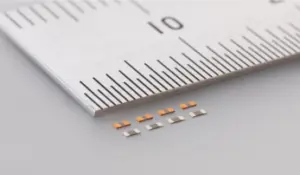source: Taiyo Yuden news
TOKYO, September 27, 2016
TAIYO YUDEN CO., LTD. announced today the commercialization of the low-profile multilayer ceramic capacitors PMK105 BJ474ML and PMC105 BJ474ML (both 1.0 x 0.5 x 0.11 mm, with height as the maximum value).
These products can be used in devices that are required to be small and thin, such as smartphones and wearable devices, for the purpose of decoupling IC power supply lines for embedded-parts multilayer wiring substrates and various modules. The capacitance enhancement technique TAIYO YUDEN has nurtured enables the capacitor products to achieve a capacitance of 0.47μF at a height of 0.11 mm, which is the world’s thinnest profile for multilayer ceramic capacitors. Production of this multilayer ceramic capacitor commenced at the company’s Tamamura Plant (Tamamura-machi, Sawa-gun, Gunma Prefecture, Japan) from September 2016 at a production rate of 10 million units per month, with a sample price of 15 yen per unit.
Technology Background
Multilayer ceramic capacitors are placed near IC devices mounted in a smartphone or a wearable device for the purpose of decoupling. In accordance with reductions in the size and thickness of
devices and the need for improved functionality, the mounting area available for various parts is decreasing. There is a need to implement higher-density mounting, which includes mounting
low-profile parts inside or at the back of the IC package and embedding them in the substrate, rather than using the conventional method of mounting parts on the printed circuit board.
Furthermore, for stably driving the IC device, multilayer ceramic capacitors for the purpose of decoupling are required to have a larger capacity while maintaining their small form.
To address this market need, TAIYO YUDEN has commercialized the 1005 -size multilayer ceramic capacitors with the industry’s largest capacitance of 0.47μF in a 0.11 mm profile by refining the conventional capacitance enhancement technique to reduce the thickness of the external electrodes. Moreover, the PMC105 BJ474ML product has copper-plated electrodes, which are suitable for mounting on embedded -parts multilayer wiring substrates. We will continue to actively promote the development of low-profile multilayer ceramic capacitors with a smaller, thinner profile and a higher capacitance.
Applications
For decoupling IC power supply lines for embedded-parts multilayer wiring substrates and various modules, particularly in devices that are required to be small and thin, such as
smartphones and wearable devices.


































